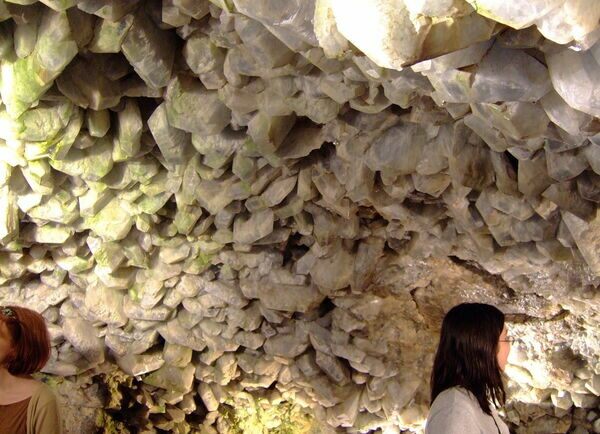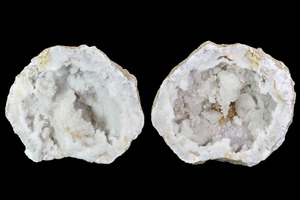What is the largest geode in the world?
Geodes are defined as somewhat spherical or egg shaped rock structures containing a hollow cavity lined with minerals. They are often lined with crystals. Most geodes are small, several inches across but a few of gigantic proportions have been discovered. There are two candidates that are claimed to hold the title of the world's largest geode. The Pulpi Geode in Spain and Ohio’s Crystal Cave. There are also some other noteworthy amethyst geodes which have been discovered in Uruguay.
Located in an abandoned silver mine near the town of Pulpí, Spain this massive, 390 cubic foot (11 cubic meter) geode is said to be the largest in the world. It is 26 feet long, 6 feet wide, 5.5 feet high and lined with massive selenite crystals up to 6 feet long. The selenite crystals are incredibly pure, so translucent that you can see your hand through them.
This immense geode was formed in two different phases, the first starting about 6 million years ago. A large, hollow space formed within the rock as acidic water dissolved the soluble dolomites which form the Sierra del Aguilón mountain range. Then, as the water temperature and water chemistry changed, gypsum started precipitating out of the groundwater forming selenite crystals along the walls of the cavity. Based on the size of the gypsum crystals, it’s believed that they started forming less than 2 million years ago.
The Pulpi Geode was discovered in 1999 by members of the Mineralogist Group of Madrid within the abandoned mine. For years the geode was sealed off to prevent vandalism, but in August, 2019 it was opened for public tours.
Some people have noted that the Pulpi geode probably shouldn't count as a geode in a classical sense due to it's shape not being particularly spherical.
A massive, celestite crystal lined geode located near Put-in-Bay, Ohio also is said to be the largest geode ever found. It measures a staggering 30 feet (10 meters) long but was larger when it was first discovered.
In 1887, a German immigrant Gustav Heineman found this gigantic geode at a depth of 30 feet while digging a well beneath his winery. The walls were lined with well-developed, tabular celestite crystals up to 3 feet long. Gustav originally mined the celestite crystals for their strontium. Strontium was used in the manufacture of fireworks as it gives off a brilliant red flame when burned. However, he later decided to halt mining and turn the crystal cave into a tourist attraction. Tours of the natural phenomenon are operated to this day by the Heineman Winery.
Conflicting and incomplete dimensions have been reported for this geode making it difficult to verify the competing claims for the world’s largest geode.
The 120 million year old basalt flows in Artigas, Uruguay are famous for producing beautiful, dark purple amethyst geodes. The geodes began as gas bubbles that were trapped within molten lava as it cooled, leaving hollow spaces. Over millions of years, groundwater precipitated silica inside of these cavities, forming quartz crystals on their walls. Most of these geodes are less than a foot across but occasionally they can reach impressive sizes.
While, none have been discovered which match the dimensions of the Pulpi Geode or Ohio’s crystal cave, some amethyst geodes from Uruguay are particularly noteworthy.
According to Guinness World Records, the largest one is a 28,660 lb (13,090 kg) monster located at the Shandong Tianyu Museum Of Natural History in China. It measures 9 feet 10 inches (3m) long, 5 feet 10 inches (1.8m) wide and is 7 feet 2 inches (2.2 meters) high. But this is certainly not the largest amethyst geode...
A more recently discovered Uruguayan amethyst geode currently located at the Crystal Castle & Shambhala Gardens in Byron Bay, Australia weighs in at over 44,000 lbs (20,000 kg). It measures an astounding 18 feet (5.5m) wide. Dubbed the "Enchanted Cave" it was reportedly found by a farmer in Artigas, Uruguay.
If you are in the market for a massive amethyst geode contact us.
And a few other massive amethyst geodes...
The Pulpi Geode In Spain
Located in an abandoned silver mine near the town of Pulpí, Spain this massive, 390 cubic foot (11 cubic meter) geode is said to be the largest in the world. It is 26 feet long, 6 feet wide, 5.5 feet high and lined with massive selenite crystals up to 6 feet long. The selenite crystals are incredibly pure, so translucent that you can see your hand through them.
This immense geode was formed in two different phases, the first starting about 6 million years ago. A large, hollow space formed within the rock as acidic water dissolved the soluble dolomites which form the Sierra del Aguilón mountain range. Then, as the water temperature and water chemistry changed, gypsum started precipitating out of the groundwater forming selenite crystals along the walls of the cavity. Based on the size of the gypsum crystals, it’s believed that they started forming less than 2 million years ago.
The Pulpi Geode was discovered in 1999 by members of the Mineralogist Group of Madrid within the abandoned mine. For years the geode was sealed off to prevent vandalism, but in August, 2019 it was opened for public tours.
Some people have noted that the Pulpi geode probably shouldn't count as a geode in a classical sense due to it's shape not being particularly spherical.
The Crystal Cave In Ohio
A massive, celestite crystal lined geode located near Put-in-Bay, Ohio also is said to be the largest geode ever found. It measures a staggering 30 feet (10 meters) long but was larger when it was first discovered.
In 1887, a German immigrant Gustav Heineman found this gigantic geode at a depth of 30 feet while digging a well beneath his winery. The walls were lined with well-developed, tabular celestite crystals up to 3 feet long. Gustav originally mined the celestite crystals for their strontium. Strontium was used in the manufacture of fireworks as it gives off a brilliant red flame when burned. However, he later decided to halt mining and turn the crystal cave into a tourist attraction. Tours of the natural phenomenon are operated to this day by the Heineman Winery.
Conflicting and incomplete dimensions have been reported for this geode making it difficult to verify the competing claims for the world’s largest geode.
Massive Amethyst Geodes From Uruguay
The 120 million year old basalt flows in Artigas, Uruguay are famous for producing beautiful, dark purple amethyst geodes. The geodes began as gas bubbles that were trapped within molten lava as it cooled, leaving hollow spaces. Over millions of years, groundwater precipitated silica inside of these cavities, forming quartz crystals on their walls. Most of these geodes are less than a foot across but occasionally they can reach impressive sizes.
While, none have been discovered which match the dimensions of the Pulpi Geode or Ohio’s crystal cave, some amethyst geodes from Uruguay are particularly noteworthy.
According to Guinness World Records, the largest one is a 28,660 lb (13,090 kg) monster located at the Shandong Tianyu Museum Of Natural History in China. It measures 9 feet 10 inches (3m) long, 5 feet 10 inches (1.8m) wide and is 7 feet 2 inches (2.2 meters) high. But this is certainly not the largest amethyst geode...
A more recently discovered Uruguayan amethyst geode currently located at the Crystal Castle & Shambhala Gardens in Byron Bay, Australia weighs in at over 44,000 lbs (20,000 kg). It measures an astounding 18 feet (5.5m) wide. Dubbed the "Enchanted Cave" it was reportedly found by a farmer in Artigas, Uruguay.
If you are in the market for a massive amethyst geode contact us.
And a few other massive amethyst geodes...
 Reviews
Reviews









